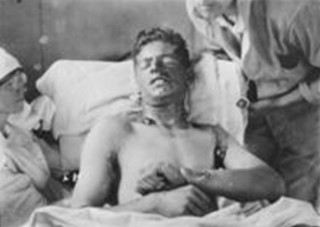Machine Guns, Mines and Poison Gas in WWI
by Reuben
(SYDNEY)

German Chlorine gas attack
New Weapon Technology in World War I increased the death toll dramatically. The use of new effective machine guns, explosive mines and poison gas made this war different from the rest. Trench lines protected by barbed wire, and machine guns were nearly an impossible front to cross. Sergent Charles Quinnell, who went into attack on the Western Front, in July 1916, vividly recalling the power of defensive technology (machine guns) said, "The first wave were down, two machine guns played on them and they were completely wiped out. Everybody was either killed or wounded. We went through, we got halfway across (no man's land) and then the machine guns found us and they played on us like spraying with a hose. At the finish I was the only one standing..."
Imperial War Museum, Book of the First World War By Malcolm Brown (Ed.)
Would you be ready to obey an order like that? Would you be ready to run like that, for your country, and die by machine guns fire?
Machine guns were a new extremely effective way to defend a line of trenches. Machine guns had been used in only one other war which was the Boer war. In this war, the guns were not very effective. In the Navy, Nordenfelt machine guns were fitted. These guns could fire 3000 bullets in 3 minutes and 3 seconds. These guns worked by sliding a lever forward and then back, loading and firing the gun. They were fed by an ammunition box on top and its loading mechanism worked by weight. Then a man named Hiram Maxim in 1884 took out patents for his machine gun. This gun reloaded itself, and is considered the first true machine gun. On the Gallipoli campaign there was a battle called The Nek. In this battle, the Australians and New Zealanders were ordered to attack a hill from two sides; the New Zealanders arrived and attacked late and the attack was a complete failure. The men were ordered up the hill in waves of 150 men each. They charged every 2 minutes, and because of the machine guns hardly anyone made it to the enemy trenches, where they were killed. After four waves of men had been sent over, the attack ended. This defeat shows how powerful the defensive machine gun was.
Mines and booby traps have been around for hundreds of years. In early civilizations, such as the Mayans, traps were made to catch animals and dangerous predators. In the World Wars, traps were still being made, but they were of a different nature. These traps were made to blow up and destroy anyone or anything in the area. During trench warfare, mines were continually driven to undermine the enemy trench. During the Gallipoli campaign, when the Anzacs were retiring from their defences, the Allies wired everything. They made special time triggers to fire the guns, to make the enemy believe that they were still there. Also every man had to create a bomb of some kind, which they fastened to helmets, trip-lines, railings, doors, and everything else. The withdrawal from Gallipoli was a success, not a man was killed.
Poison gas killed a third of the population who died in WWI. There were three main gases: Chlorine gas, Mustard gas and Phosgene gas. In the first battle of Ypres, the Germans let out, in a strong breeze, 160 tons, (5,730 cylinders) of Chlorine gas. This gas created a grey-green cloud that swept down to the French trenches. The French frightened by it abandoned their trenches and fled, leaving an 8,000 yard gap in their lines. Luckily, the Germans were afraid to attack and British and Canadian reinforcements arrived. Chlorine was an ineffective weapon, and its killing powers were small. The British Official History, after a gas attack stated, "90 men died from gas poisoning in the trenches; of the 207 brought to the nearest dressing stations, 46 died almost immediately and 12 after long suffering."

The British were angered by the German gas attacks, and said it was base, but soon they too were working with vigour, making their own gas which they released on the 25th of September 1915. 140 toms of gas were released at the Germans. Un-luckily, the wind was fickle, and it blew back on the ally lines. In the same year the Germans overcame the problems of Chlorine gas, and introduced phosgene gas. This gas was difficult to detect as it had the odour of mouldy hay. Phosgene gas was also mixed with chlorine to make it more deadly. Instead of opening containers of gas into a breeze, they loaded it into shells, and bombed it into enemy territory. In the first combined gas (Phosgene and Chlorine) attack, the gas caused 1069 casualties, and 69 deaths. The most deadly gas in WWI was Mustard gas. Mustard gas was fatal if it was taken in large amounts, but it was far more largely used, as a gas to disable, and harass an enemy. Mustard gas was heavier than air, and settled on the ground polluting the battlefield. It was delivered in shells and caused severe burns, blindness and vomiting. Internal and external bleeding began, and it usually took four to five weeks for a man to die. Mustard gas exposure was so painful that the victims were often strapped to their beds.
Due to the terrible new measures of attack and defence, World War One, resulted in an extreme loss of life. Because it was so hard to attack, and so much easier to defend, the war came to a standstill. In most battles, as troops attacked, they were mowed down by machine guns. In retreats, they were blown up by hidden bombs, and at night, gas swept over them. What a way to fight.
Written By
Reuben (Age 16, October, 2007)











